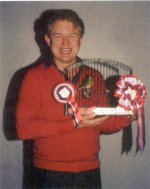
Hints and Tips To Help Your Birds' Placings
The largest Fife canary show in the country is the North of England FFCC Club Show, held each year on the penultimate Sunday in November in West Yorkshire. Over 1,200 birds are now entered each year and it is only a question of time before there is an entry of 2,000 birds at a major Fife show.
 Selecting
Exhibition Stock
Selecting
Exhibition Stock
By the end of August most young Fife canaries will be through the moult with only the head feathers to come through (denoting adult plumage) and the final gloss to be put on the youngsters’ new feathers.
It is difficult for anyone to predict accurately at this stage, which Fifes are possible National winners as the youngsters change shape so frequently during the moult. Many appear slightly over-large but, when the feathers are complete, they are of a good pear-shaped and diminutive size. Others look like world-beaters at 4 weeks of age but ‘run away’ at the later stages. That is why exhibits that will do well at the early shows occasionally fail to do well later in the season.
As the fancier improves the quality of his or her stud over the years, the final selection gets more and more difficult as there is less to choose between the birds. At this stage the task cannot be undertaken until the Fifes have moulted out completely. That is why, these days, I do not even look in too much detail at my young Fifes until September when I remove them from their moulting flight cages.
The moult takes more out of the birds and is much longer than is often realised. It will take some birds 3 months to complete their moult; although the later bred birds will take a little less.
Show Team
By October the young Fifes selected as the show team should be housed in single cages and spending an hour a day in a training cage or normal show cage. After the hour put the young bird back into a different single cage. That way it will not become accustomed to the same cage. Until the bird has been out to a couple of early shows it needs to have its confidence developed by being moved around and placed in different cages. Place the show cage in a different position each time the bird is trained.
At this time of year encourage other people into the birdroom to get the birds used to different people, and create a little noise by leaving the radio on all day.
The first canary shows are usually held in early October and the specialist Fife shows from late October onwards.
Retention of Stock
At the end of the breeding season the Fife fancier needs to decide which of his flighted birds he is going to retain for the following breeding season. This is usually determined by:
-
The number of Fifes to retain each year so that half will be flighted and half unflighted.
-
The quality of the old birds.
-
The breeding success of the birds.
If your normal breeding programme contains four Clear Yellow Cocks and four Clear Buff Cocks, for example, then two flighted birds of each should be retained.
The cock birds that did well on the show bench last season will normally be retained. However, if one of the other cock birds bred well and produced half a dozen youngsters, all of show quality, then he should be retained at the expense of one of the better show birds if that Fife did not breed well or only produced average youngsters.
The birds which produce the winners should be retained.
Exhibiting and Judging
 |
The culmination of the year’s breeding season is the preparation of a good show team of Fife fancy canaries to go to the first show in October. There is nothing quite as satisfying as running your show team into their black, clean, shining show cages to show off the quality of the bird. No matter how well they perform at the show it is enjoyable to see your own birds staged in good condition after a summer’s effort of breeding and rearing. However, nothing beats the thrill of entering a show hall and seeing one of your Fifes surrounded by rosettes as Best Bird In Show – or one of the top ones, anyway. Novices should serve 5 years in that status before moving up into champion status, so do not be in a hurry to move into that category –enjoy and learn as a novice. |
Fife Classification
Every year newcomers to the hobby will be showing their Fifes for the first time, and the classifications can be quite difficult to understand.
In general, Fifes are shown at three types of show:
-
Local cage bird society club shows, which are run for their members only.
-
Open shows, which are run by local cage bird societies but encourage birds from outside the area.
-
Specialist Fife shows, in which only Fifes are exhibited.
It is essential to visit the cage bird society shows but it is even more important to go to, and exhibit at, the major specialist shows, the largest of which is the North of England FFCC Show, held on the penultimate Sunday in November, at which well over 1,200 fifes from all over Great Britain can be seen and compared.
![]()
Email:- terry@fifecanaries.com
(c) Terry Kelly & SL